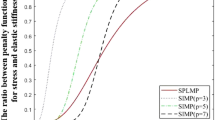Abstract
The boom structure is a key component of giant boom cranes, and the stability-ensured topology optimization is critical to its lightweight design. The finite difference method, direct differentiation or adjoint method needs many time-consuming nonlinear analyses for this problem with a large number of design variables and constraints, and the last two methods are difficult to implement in off-the-shelf softwares. To overcome these challenges, this work first defines a global stability index to measure the global stability of the whole structure, and a compression member stability index to identify the buckling of compression members. Numerical and experimental verifications of these two stability indices are conducted by analyzing a simple three-dimensional frame. Next, the anti-buckling mechanism of boom structures is analyzed to develop the precedence order of freezing relative web members. The stability indices and the freezing measure are then utilized as a part of a novel Stability-Ensured Soft Kill Option (SSKO) algorithm, built upon the existing Soft Kill Option (SKO) method. The objective is to minimize the discrepancy between structural volume and predetermined target volume, while the global stability and stress are regarded as constraints. Lastly, the SSKO algorithm with different scenarios is applied to topology optimization problems of four-section frames and a ring crane boom; in both cases the consistent and stable topologies exhibit applicability of the proposed algorithm.






























Similar content being viewed by others
References
American Institute of Steel Construction (AISC) (2010) Specification for structural steel buildings ANSI/AISC 360–10. AISC, Chicago, USA
Baumgartner A, Harzhem L, Mattheck C (1992) SKO (Soft Kill Option) - the biological way to find an optimum structure topology. Int J Fatigue 14(6):387–393
Bojczuk D, Mroz Z (1999) Optimal topology and configuration design of trusses with stress and buckling constraints. Struct Optim 17(1):25–35
Browne PA, Budd C, Gould NIM, Kim HA, Scott JA (2012) A fast method for binary programming using first-order derivatives, with application to topology optimization with buckling constraints. Int J Numer Methods Eng 92(12):1026–1043
Chen J (2011) Stability of steel structures theory and design. Science Press, Beijing, Fifth Edition edn [In Chinese]
Cheng G (2012) Introduction to optimum design of engineering structures. Dalian University of Technology Press, Dalian [In Chinese]
Duysinx P, Sigmund O (1998) New developments in handling stress constraints in optimal material distribution. Paper presented at the 7th AIAA/USAF/NASA/ISSMO Symposium on Multidisciplinary Analysis and Optimization, St. Louis, MO
Eschenauer HA, Olhoff N (2001) Topology optimization of continuum structures: a review. Appl Mech Rev 54(4):331–390
Fan F, Yan J, Cao Z (2012) Stability of reticulated shells considering member buckling. J Constr Steel Res 77:32–42
Galambos TV (1998) Guide to stability design criteria for metal structures, 5th edn. Wiley, USA
Harzheim L, Graf G (2005) A review of optimization of cast parts using topology optimization - I - topology optimization without manufacturing constraints. Struct Multidiscip Optim 30(6):491–497
Harzheim L, Graf G (2006) A review of optimization of cast parts using topology optimization - II - topology optimization with manufacturing constraints. Struct Multidiscip Optim 31(5):388–399
Hjelmstad KD, Pezeshk S (1991) Optimal design of frames to resist buckling under multiple load cases. J Struct Eng ASCE 117(3):914–935
Kemmler R, Lipka A, Ramm E (2005) Large deformations and stability in topology optimization. Struct Multidiscip Optim 30(6):459–476
Lawrence KL (2011) ANSYS tutorial release 13. Stephen Schroff, Mission
Li WJ, Zhou QC, Zhang XH, Xiong XL, Zhao J (2013) Topology optimization design of bars structure based on SKO method. Applied Mechan Mat 394(1):515–520
Li WJ, Zhao J, Jiang Z, Chen W, Zhou QC (2015) A numerical study of the overall stability of flexible giant crane booms. J Constr Steel Res 105:12–27
Lin C-Y, Sheu F-M (2009) Adaptive volume constraint algorithm for stress limit-based topology optimization. Comput Aided Des 41(9):685–694
Lindgaard E, Dahl J (2013) On compliance and buckling objective functions in topology optimization of snap-through problems. Struct Multidiscip Optim 47(3):409–421
Lindgaard E, Lund E (2010) Nonlinear buckling optimization of composite structures. Comput Methods Appl Mech Eng 199(37–40):2319–2330
Lindgaard E, Lund E (2011) A unified approach to nonlinear buckling optimization of composite structures. Comput Struct 89(3–4):357–370
Lund E (2009) Buckling topology optimization of laminated multi-material composite shell structures. Compos Struct 91(2):158–167
Manickarajah D, Xie YM, Steven GP (2000) Optimisation of columns and frames against buckling. Comput Struct 75(1):45–54
Mase GT, Mase GE (1999) Continuum mechanics for engineers, 2nd edn. CRC Press, New York
Ohsaki M, Ikeda K (2007) Stability and optimization of structures generalized sensitivity analysis. Springer, New York
Pyrz M (1990) Discrete optimization of geometrically nonlinear truss structure under stability constraints. Struct Optimiz 2(2):125–131
Rozvany GIN, Sobieszczanski-Sobieski J (1992) New optimality criteria methods: forcing uniqueness of the adjoint strains by corner-rounding at constraint intersections. Struct Optimiz 4(3):244–246
Shen Z, Su C, Luo Y (2007) Application of strut model on steel spatial structure. Building Struct 37(1):8–11 [In Chinese]
Sigmund O, Maute K (2013) Topology optimization approaches - a comparative review. Struct Multidiscip Optim 48(6):1031–1055
The electronic universal testing machine RGM-4300. (2014) REGER. http://www.reger.com.cn
The VIC-3D System. (2014) Correlated Solutions, Inc. http://www.correlatedsolutions.com
Tortorelli DA, Michaleris P (1994) Design sensitivity analysis: overview and review. Inverse Prob Eng 1(1):71–105
Yura JA (2006) Five Useful Stability Concepts. Paper presented at the Proceedings of the 2006 Structural Stability Research Council Annual Stability Conference, San Antonio, Texas
Acknowledgments
Funding for this research was provided by the National Natural Science Foundation of China (NSFC) under award number 51375345. Financial support for the first author, Wenjun Li, was provided in part by the China Scholarship Council. The views expressed are those of the authors and do not necessarily reflect the views of the sponsors.
Author information
Authors and Affiliations
Corresponding author
Rights and permissions
About this article
Cite this article
Li, W., Zhou, Q., Jiang, Z. et al. Stability-ensured topology optimization of boom structures with volume and stress considerations. Struct Multidisc Optim 55, 493–512 (2017). https://doi.org/10.1007/s00158-016-1511-5
Received:
Revised:
Accepted:
Published:
Issue Date:
DOI: https://doi.org/10.1007/s00158-016-1511-5



